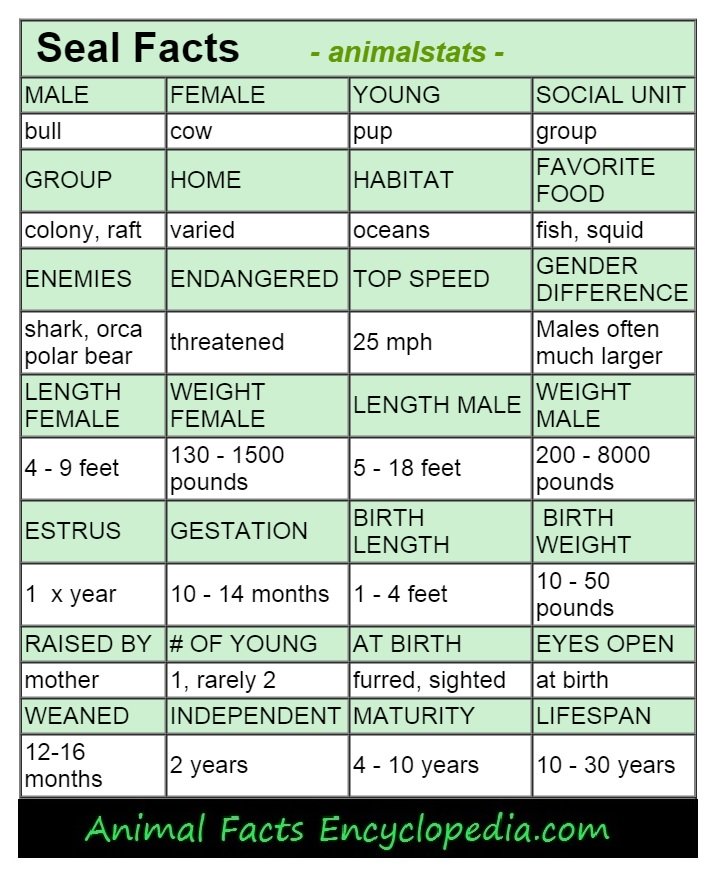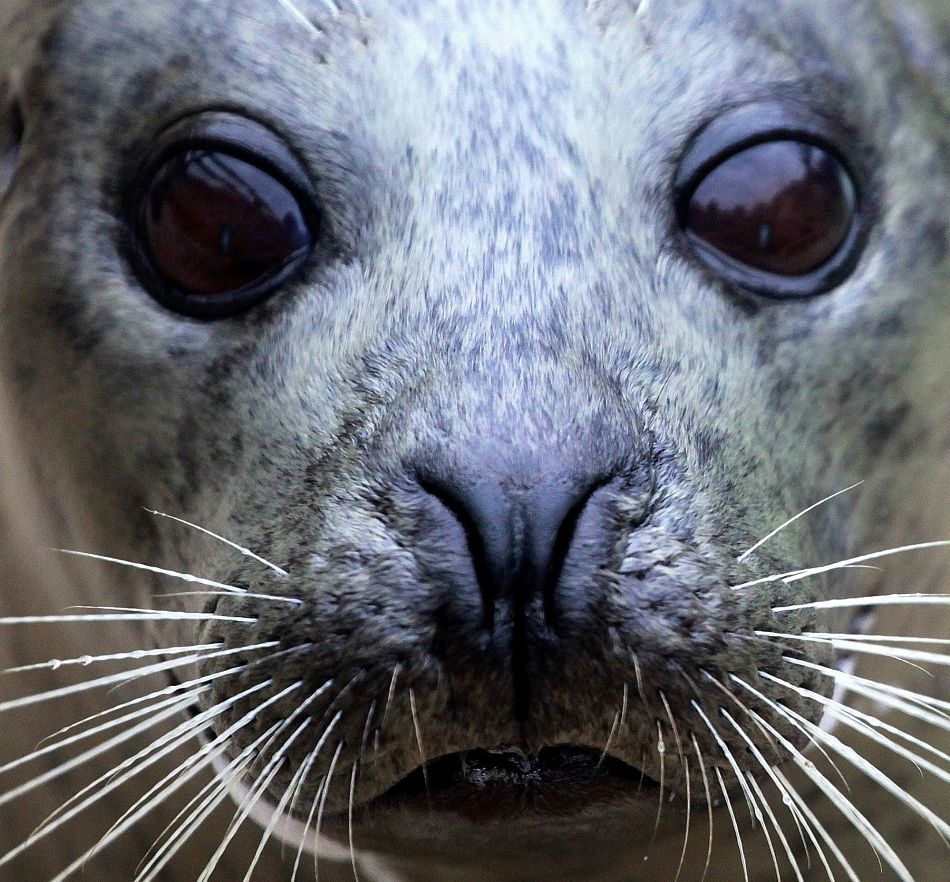seal Facts
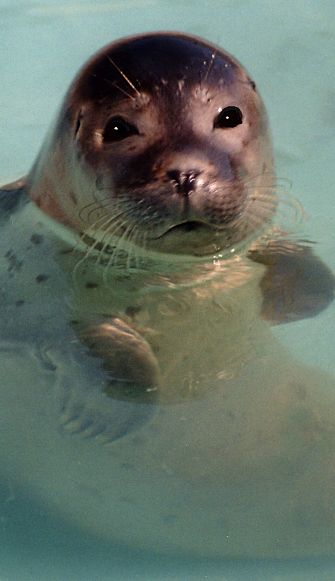 Portrait of a Seal
Portrait of a SealThe true seals, also known as the earless seals and the crawling seals, are over 18 species of semi-aquatic marine mammals of the family Phocidae. They are one of three families within the super family known as pinnipeds.
Pinniped means feather(pinni) foot(ped) in Latin. The other two families are the walrus, alone in its own genus, and the sea lions.
Sea lions and fur seals are known as eared seals or walking seals. True seals differ from sea lions in that they have no external ears, and are unable to walk on all-fours as the sea lions can.
The fur seals are also in the sea lion family and are not true seals, although they are called by the name "seal", but all the pinnipeds, seals, walruses and sea lions, are all seals, as lions and cheetahs and domestic cats are all cats. So it is not wrong to call a sea lion or a walrus a seal, just as it would not be wrong to call a jaguar or a mountain lion a cat, just a little less accurate.
The seals ancient ancestors were land animals, probably somewhat similar to otters.
For reasons unknown, these terrestrial creatures returned to the ocean about 20 million years ago, where they have since become the most successful and widely distributed family of carnivores in the world.
Seals live mostly in very cold, often frozen environments, and their bodies are layered in blubber to protect them from the elements. Blood actually migrates to the exterior layers of blubber when the animal needs to cool down, and flows back to the interior layers, close to the bodies core, when the temperature is colder.
The body of a seal is specifically structured for life in the water, with a smooth, torpedo shaped torso, and flattened, powerful flippers, like four large swim fins instead of feet. In fact, the swim-fins scuba divers and backyard snorkelers use were modeled after the unique, compressed and web-toed feet of a seal.
Most seal species live in very large social groups called colonies that may come together to sunbathe in masses of hundreds, and take to the beach to mate and raise young in tightly packed gatherings of thousands.
On land they are extremely cumbersome, and must move their often enormous bodies by wriggling almost like a worm. Some species move around by bouncing, some pull themselves forward with their front flippers, and many seals will also occasionally roll their bodies one or two revolutions to one side or the other if they wish to move short distances.
In the ocean though, seals swim with exceeding grace and swiftness, using all four flippers for both propulsion and steering. Some species can dive 1000 feet deep and remain submerged for over an hour.
They have larger volumes of blood and a greater concentration of oxygen in the blood than any land animals, and they expel all oxygen from their lungs before they dive, avoiding issues such as "the bends".
In dives as deep as 1000 feet and as long as 100 minutes, their special bodies survive on only the oxygen in their blood.
seal lifestyle and reproduction
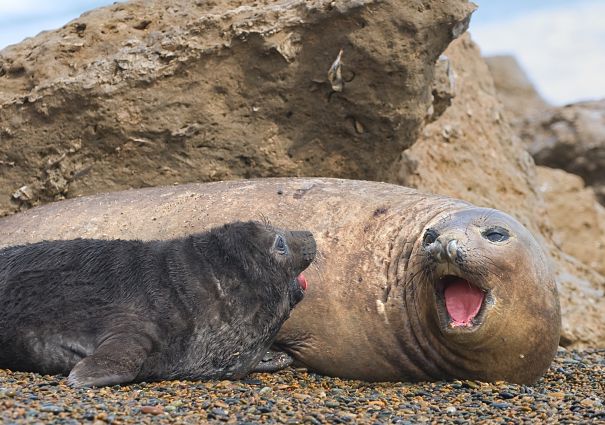
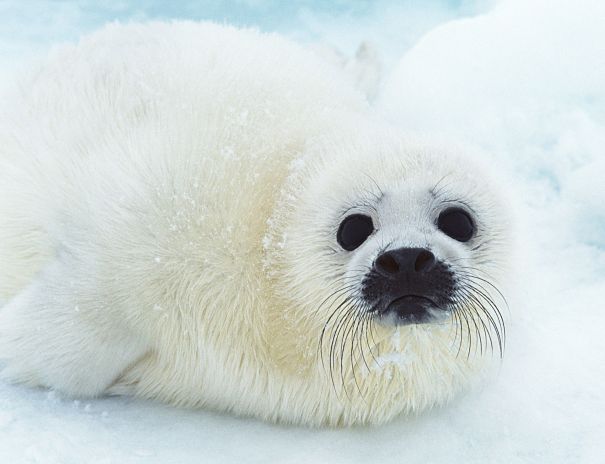
There are over 18 species of true seals, most of which display varying extents of sexual dimorphism - an obvious difference in appearance between males and females. Depending on the species, male seals can be larger than females by as much as five times, and in several species, such as the hooded and elephant seals, mature males have distinct pendulous noses and other facial features.
Seals are highly social and desire close contact, but don't really have close relationships. They may move about among hundreds of other seals happily communing with dozens of individuals. Although they live in large groups seals are solitary hunters diving several hundred feet deep in search of fish, crustaceans and squid.
Lifestyle naturally varies among the many species, but seals, in general, are promiscuous, and males do not contribute to the raising of young. Seals migrate between breeding grounds and feeding grounds, traveling several hundred to up to two thousand miles a year.
When females arrive at the breeding grounds, which are called rookeries, the males have already staked claims to prime areas, battling each other with loud roaring, charges and sometimes violent contests.
Females arrive already pregnant from the previous season, and give birth to one baby, called a pup, within a few days of arriving. After the birth of the baby the mother seal will remain on land for up to 6 weeks, nursing the pup till it is three times its birth weight.
In some species, such as the familiar harp seal, the mother fasts for a few weeks, doing nothing but nursing her newborn, then, after only 4 to 5 weeks, she leaves the pup for good, returning to the ocean to mate again.
The harp seal pups are snow white in color to camouflage them in their snowy environment, which is critical over the next week or two, as they begin to forage and fend for themselves.
Other seals spend more time nurturing their young ones, but many species use this method of complete dedication by the mother for a few weeks and then basically a cold turkey abandonment.
Groups of forlorn pups gather on beaches calling for their mothers and falling prey to killer whales, and polar bears. Eventually the strongest survivors take to the water and find their way to the feeding grounds which may be hundreds of miles away.
what is the difference between seals and sea lions?
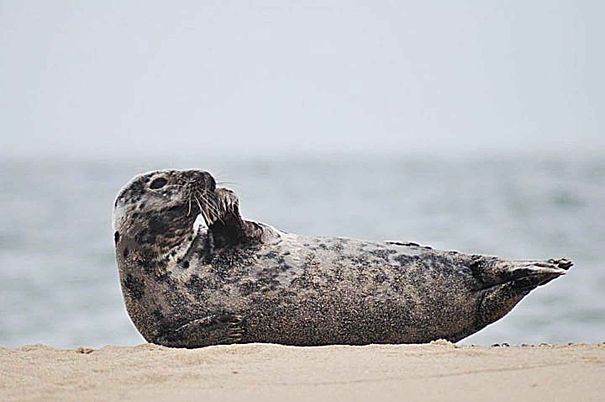 seal on the beach
seal on the beach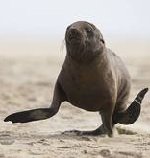 sea lion running
sea lion runningSea lions are members of the seal or pinniped family. The word pinniped means "flipper feet" or "feather feet" and includes three types of semi-aquatic marine mammals. The walrus, the "true seals" and the "eared seals" or "walking seals".
There are 7 species of sea lions and 9 species of fur seals that make up the "earred seals".
Eared seals differ from true seals in that they have external ears, larger, more powerful forelimbs, and can rotate their hind limbs forward and beneath them. These differences in skeletal structure allow the sea lion and fur seal to not only sit in a semi-upright position, (that classic pose), but also to walk and even run on all-fours.
In contrast, the rear limbs of true seals are fused together and are permanently facing rearward making walking impossible.

All pinnipeds, even walruses, are considered seals, in the same broad sense that leopards are considered cats, so it is not incorrect to call a sea lion a seal, just less precise.
Eared seals spend a great deal of time on land, breeding and sunning on the shores. With long, powerful front flippers, their natural position is upright with the chest raised off the ground. Their rear legs are two separate, front-facing flippers that can be rotated under the body, and they can rise up and move around with a two beat gate.
Also often referred to as the "walking seals", the eared seals can actually walk, and even run, quite rapidly when necessary.
The "true seals" have no external ear flaps, smaller front flippers and rearward facing hind limbs that are fused together into one scalloped flipper. They move across land by stretching their upper bodies out and arching their backs to pull themselves forward.
True seals also swim differently from eared seals, getting most of their propulsion from their fused, tail-like rear flippers and undulating motions similar to a dolphin to propel themselves, while the eared seals use their strong front flippers as big, highly effective oars, appearing to fly through the water like birds.
Walruses have skeletons designed more like the eared seals, but have no ears. They move like the true seals in the water, but like the eared seals on land, and so are somewhere in between these two groups, and are classified in a genus of their own. - Seal Facts

elephant seal - worlds largest land carnivore
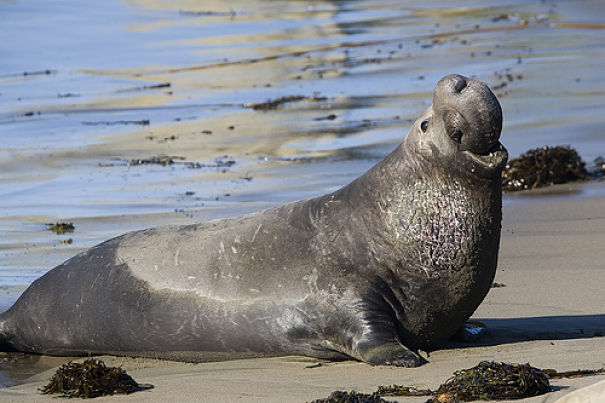
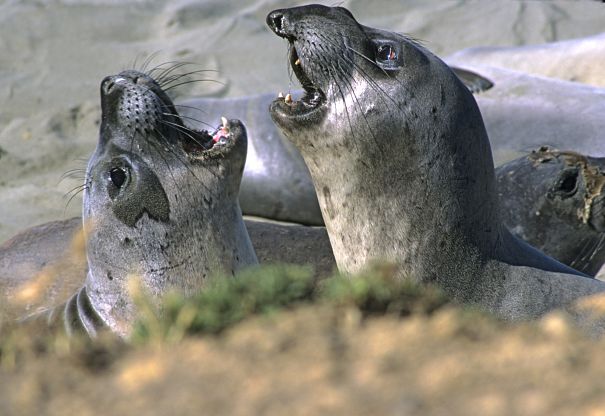
Seal species cover a wide range of sizes with the smallest being the 4 foot Baikal seal, and the largest being the gigantic Southern elephant seal.
Elephant seals get their names from the appearance of mature males, who are not only enormous, but also develop pendulous, trunk-like noses. These noses are multi-chambered and can be inflated with air to help the male make incredibly loud roars which intimidate rivals and impress females.
The female Southern elephant seal averages about 10 ft in total length, but the male Southern elephant seal averages 16 feet in length and weighs over 7000 pounds. The biggest adult males can be almost 20 feet long and top 8500 pounds.
The elephant seal is not only the largest pinniped, (way bigger than a walrus) but also the largest terrestrial carnivore, dwarfing such animals as African lions (826 pounds record weight) and polar bears,(2209 pounds record weight).
Found on the beaches of New Zealand, Argentina and South Africa, the Southern elephant seal is land-bound for two separate one month long periods each year.
First is mating season where males will remain on the beach and fast for weeks while establishing territories, and females will fast while feeding newborns. Males may battle fiercely during this time and things can get violent.
Most adult male elephant seals have many scars from battles with sharp-toothed rivals. After breeding season, they return to the water to refuel, but then beach themselves again for molting season, where they return to their mating grounds to lounge about while they regrow their top layer of skin and fur in one 30 day marathon.
Elephant seals are the most adept deep sea divers of any pinniped capable of underwater excursions of 100 minutes or more without taking a breath. - Elephant Seal Facts
 elephant seal big bulls battle
elephant seal big bulls battlelife on the ice
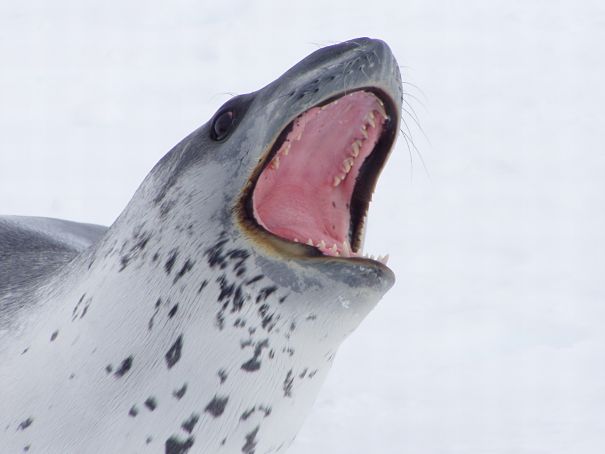 roaring leopard seal
roaring leopard sealThe majority of seal species are located in some of the coldest environments in the world. Some species spend the majority of their lives on or under the Arctic ice cap coming up for air at strategic holes that they create themselves.
Seals in these icy regions are well equipped with strong, sharp claws on their front flippers that they dig breathing holes with. They can maintain breathing holes through layers of ice up to 6 feet thick with constant tending.
Some Arctic seals like the ringed seal, a staple of the polar bears diet, actually dig out caves in the snow that covers their breathing holes. They hollow out an area known as a lair, and under the snow cover they can come up out of the water.
Ringed seals raise their pups in the lairs and usually maintain more than one at a time so they can avoid predators. Polar bears have an astounding sense of smell, however, and can detect seals hiding in lairs.
The vastness of the Arctic is the seals best defense, but if a polar bear does discover its hiding spot, the ringed seal still has a good chance of escaping back down the breathing hole into the ocean water below before the bear can claw its way though the ceiling of hard packed snow from above.
Another notorious ice dwelling seal is the rather fierce leopard seal. These very unique seal species take some of the largest prey of all pinnipeds, such as penguins and other seal species.
But as impressive a hunter as they are, one of their dietary staples is the tiny invertebrate called krill. Leopard seals teeth are specially designed to sieve krill out of mouthfuls of sea water.
They are by far the most solitary of the seal species, living alone on the ice floes of Antarctica and the sub-Antarctic islands. The leopard seal earns its name with its spotted coat, its effective hunting style, and its often gaping mouthful of dagger sharp teeth.
 seals on ice - hunting and hunted
seals on ice - hunting and huntedall in the colony, all in the raft
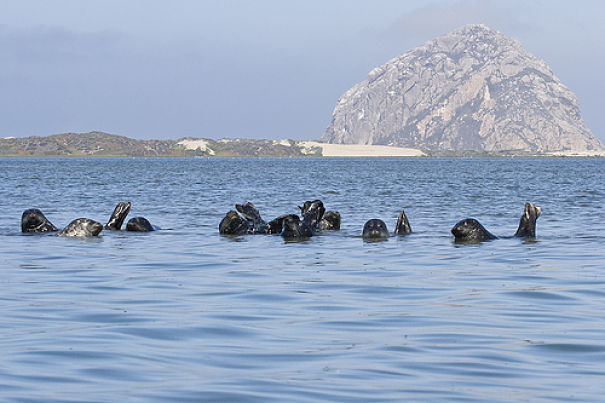
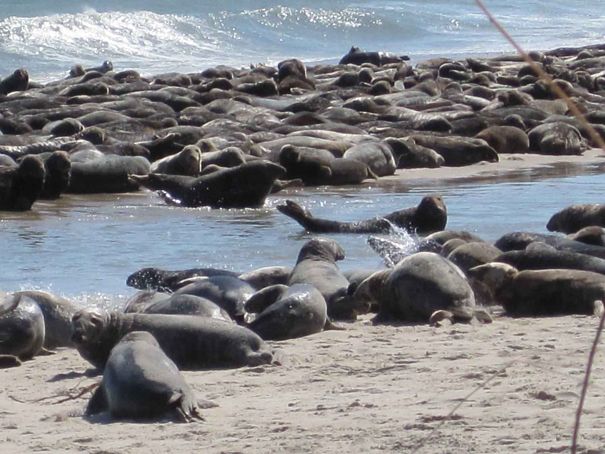
A group of seals on land is called a colony, and a group of seals in the water is called a raft.
Seals can come together during breeding season and at certain popular breeding grounds in masses of hundreds, and sometimes thousands. Crowding is not a problem, in fact close body contact is desired by most seal species.
There is lots of lounging, floating, feeding and noisy discussion in the life of a seal. A raft of seals floating in the water may appear to be a larger creature to some predators who will think twice.
Seals in water will regulate their body temperature by raising a flipper or tail out into the air. Many seal species spend equal amounts of time on land and sea, preferring isolated beaches, rocky outcrops and ice floats.
Popular lounging areas are called "haul outs" or the term can be used to describe the activity, as in "the seals are hauled out on the beach." Some species, such as elephant seals and leopard seals spend the majority of their lives in the water, only coming on land to molt once a year, and fight for breeding territory.
Mating itself takes place both on land and in the water, depending on species.
Molting requires seals to remain on land where they can more easily regulate their temperature. Fur can be seen sloughing off seals and sea lions in huge chunks during this period.
While human beings loose skin cells on a daily basis, and may replace 10 pounds of epidermis a year in tiny increments, molting involves the complete replacement of the epidermis skin and fur in the course of just a few weeks,
a few more seal facts
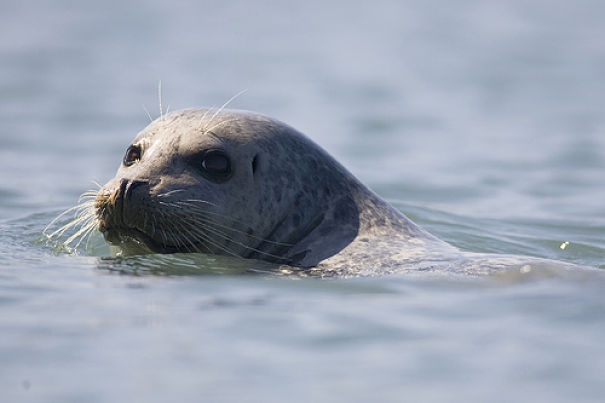
- Seals are known as the true seals, the earless seals or the crawling seals
- A male seal is called a bull, a female is called a cow, and a baby is called a pup
- A group of seals is called a colony on land, and a raft when in the water.
- The male Southern elephant seal can grow to the size of a small truck weighing over 7000 pounds and measuring over 16 feet long.
- Some seals can stay underwater for up to an hour without taking a breath
- Seals replace their skin and their fur every year in one 30 day long molt.
-
the seal is a
carnivorous (meat-eating)
diurnal (awake during the day)
aquatic (lives in and near water)
pinniped(webbed digits)
phocid (true seal family) mammal (animal with mammary glands and hair follicles) -
Scientific Classification
Class - Mammalia
Order - Carnivora
Genus - Phocidae
Species - phoca
Seal
| Seal Facts - animalstats - | |||
|---|---|---|---|
| MALE | FEMALE | YOUNG | SOCIAL UNIT |
| bull | cow | pup | group |
| GROUP | HOME | HABITAT | FAVORITE FOOD |
| colony, raft | varied | oceans | fish, squid |
| ENEMIES | ENDANGERED | TOP SPEED | GENDER DIFFERENCE |
| shark, orca polar bear | threatened | 25 mph | Males often much larger |
| LENGTH FEMALE |
WEIGHT FEMALE | LENGTH MALE | WEIGHT MALE |
| 4 - 9 feet | 130 - 1500 pounds | 5 - 18 feet | 200 - 8000 pounds |
| ESTRUS | GESTATION | BIRTH LENGTH | BIRTH WEIGHT |
| 1 x year | 10 - 14 months | 1 - 4 feet | 10 - 50 pounds |
| RAISED BY | # OF YOUNG | AT BIRTH | EYES OPEN |
| mother | 1, rarely 2 | furred, sighted | at birth |
| WEANED | INDEPENDENT | MATURITY | LIFESPAN |
| 12-16 months | 2 years | 4 - 10 years | 10 - 30 years |
see more animal extreme closeups
Recent Articles
-
African Animals - Animal Facts Encyclopedia
Oct 11, 16 10:27 PM
African Animals facts photos and videos..Africa is a wonderland for animal lovers, and a schoolroom for anyone who wants to learn about nature, beauty and the rhythm of life -
Baboon Facts - Animal Facts Encyclopedia
Oct 11, 16 10:26 PM
Baboon facts, photos, videos and information - Baboons are very distinctive looking monkeys with long, dog-like snouts and close set eyes. -
Great Apes Facts - Animal Facts Encyclopedia
Oct 11, 16 10:25 PM
Great apes facts, photos and videos..Human beings did not evolve from chimpanzees, modern chimps and gorillas do not appear in the fossil records until much more recently than homo sapiens..
